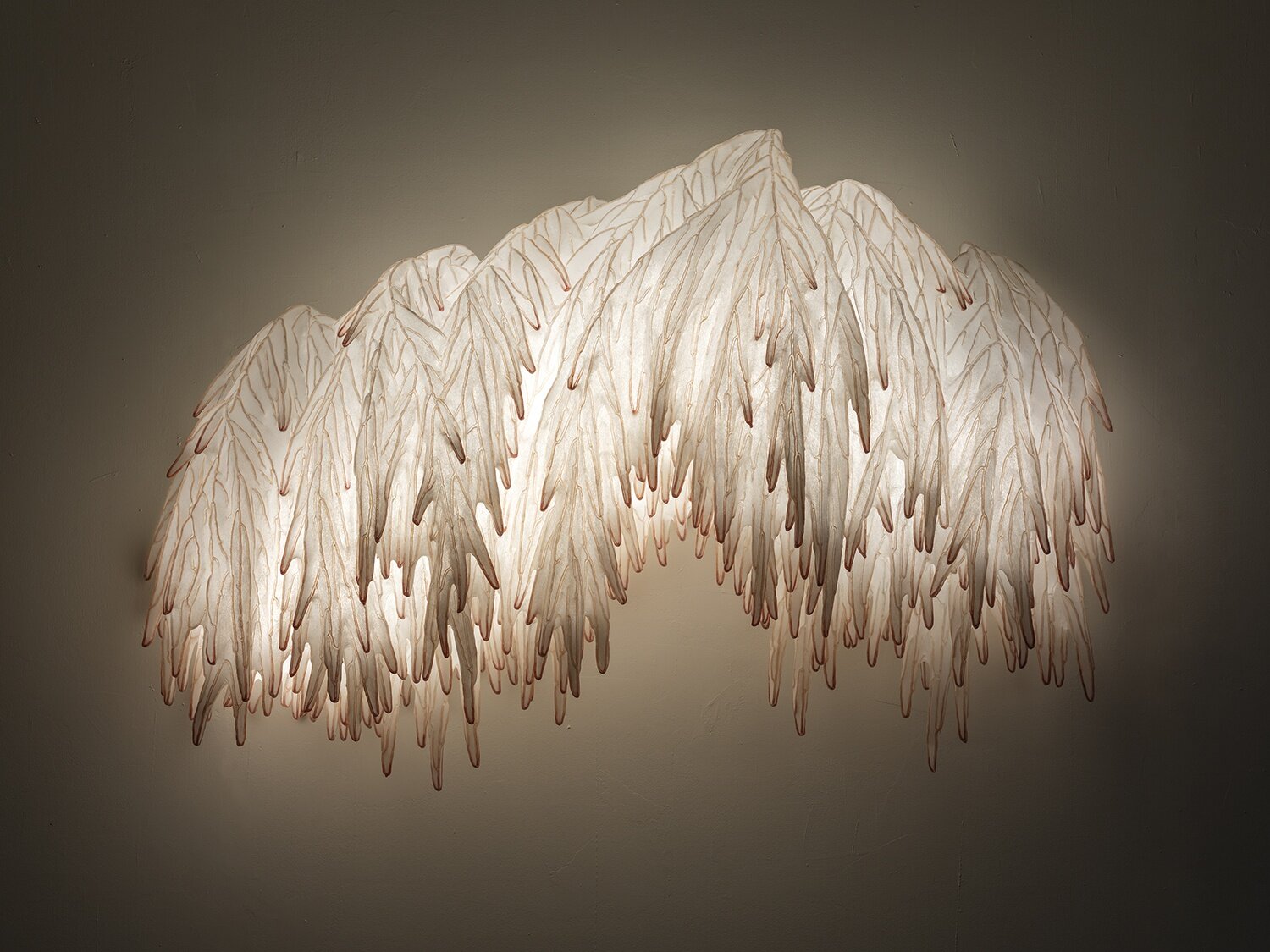That First Light Feeling
It was late and we were happy, singing, dancing and drinking together on a remote edge of Martha’s Vineyard at the end of summer. We walked down to the strip of beach off the house and put our feet in the water. Everyone spread out, chatting silhouettes. But I stopped, caught by a wash of moonlight on a seal-sized rock jutting out of the water. The light made the rock glow and cast glitter across the opaque waves. It felt like a direct connection between heaven and earth, like the moon and the rock were silently sharing some ancient wisdom and I was there to hear it. It held me, filled me with peace and then it was over. “What are you staring at?” a friend asked. All I could do was laugh and say, “the light.” I swear it wasn’t the hour or the wine - for a moment that light felt like the center of the universe and the center of my soul.
The ability of light and shadow to evoke emotion has always been one of art’s great influences. As subject, metaphor, medium and muse, natural light empowers creators to challenge what constitutes art, to question what constitutes truth and to interpret our perception of the world. As artist Lindsey Adelman puts it, “one cannot control light but collaborate with it.“
Now that summer is truly gone, fall brings its own special quality of light. But as a Boston girl whose favorite season is summer, I’m also aware that winter is coming, with its long nights and too often bleak days. So how to keep the magic light alive during the months of short daylight? How to bring that natural glow into our homes with all the emotion of moonlight hitting a sea-splashed rock?
From Tel Aviv to New York, Bucharest to Rotterdam, a cadre of rockstar, multi-hyphenate artists provide an answer. In studios crowded not with oils and canvas, but with glass, porcelain, rope, wire, and paper; where assistants don’t mix paint, but fire kilns, cast metals, cut paper and braid electrical wires, women are working to capture nature’s light in surprising and enduring ways.
These women work at the intersection of interior design, sculpture, craft and engineering. Year after year they produce astonishing work within the still male dominated manufacturing world. They are up to the challenges international lighting design presents: high volume production, technological change, material expertise, project management, transport and of course, business acumen. And still they honor nature’s contradictions: complexity that reveals simplicity, imperfection that looks like perfection and impermanence that feels like it will last forever.
Ayala Serfaty
Calling to mind Tara Donovan’s undulating styrofoam cup sculpture Untitled, installed on the ceiling of the MFA Boston, the pieces in Ayala Serfaty’s Soma series ebb with a kind of viral curiosity in their respective environments, capturing the viewer with their expansive abstraction and fiery warmth.
Ayala Serfaty, Andrea's Trust, 2006 / Museum of Fine Arts, Boston / Glass rods & polymer membrane, ceramics / 70x30x25"
Both artists seize the potential of unusual materials. While Donovan plays with manufactured mundanities like styrofoam cups, pencils and scotch tape, Serfaty uses glass rods and polymer membrane in her lighting designs. She also designs furniture. For her recent series Rapa, she hand-crafted felt from fibers she had collected all over the world.
Like the rock in the night water, Serfaty’s shapes sometimes appear like benevolent characters ready to radiate truths. She stretches the sheer polymer over the glass rods into mesmerizing, uncharted topographies, allowing the light to bleed from within. Strange and centering, her pieces makes you want to stare until you lose yourself completely in their meditative calm.
As with wavy fungus growing in ridges on the base of a tree, or ice crystals multiplying in a polar cave, Serfaty’s light sculptures change shape as the viewer moves. Deliberately abstract and unnamable, they offer new perspectives with every vantage point.
A piece from Ayala Serfaty’s Soma series
In addition to public spaces and private residences, Serfaty’s work is included in the permanent collections of many museums, including the Metropolitan Museum of Art, Museum of Arts and Design, the Mint Museum, Museum of Fine Arts in Boston, Museum of Fine Arts in Houston, Corning Museum of Glass, and Indianapolis Museum of Art.
“I would like my works to be perceived, like minerals in nature, as part of processes of crystallization and erosion. Each item that you see is meant to be associated with the accumulative memory of cells and molecular units, so that it enfolds within it the memory of the broad organic process that yielded it; each mineral item of this kind is meant to arouse the sensation that things go on crystalizing after you’re no longer there.”
An Ayala Serfaty light sculpture in a private residence
https://ayalaserfaty.com/
Lindsey Adelman
Lindsey Adelman with a piece from the Drop System Collection
A New Yorker with a reputation that spans the globe and inspires endless copycats, Lindsey Adelman is a luminary in both the design and fine art worlds. Her now iconic Branching Bubbles chandelier launched her to industry fame in 2006, the same year she opened her studio. Now she employs dozens of craftspeople and produces hundreds of works a year.
A graduate of RISD, Adelman’s artistic vision has evolved dramatically through the years. All her designs involve blown glass, which she subtly exploits for its representational complexities.
Paired with hard metal, languid fringe, rough rope or a mix of those, her glass shapes produce exciting tensions, mimicking say, a raindrop’s tussle with gravity off a branch or a stream’s holdout against freezing temperatures. As she explains it, she aims to use “a rational, modular lighting system to capture the fleeting and flawed beauty of nature."
She also explores nature’s innate molecular tension by choking her glass shapes with metal or strangling them with rope. As the glass shape sags we wonder, will it hold? Will it break? Will it change from solid to liquid and leak into a puddle on the floor?
From Lindsey Adelman’s “Catch Light” series
Some of Adelman’s series incorporate jewelry elements - metal fringe, chains, braiding - but as if the jewelry was designed for Joan Jett or Courtney Love. I like to imagine her series aligning with various musical genres. Romantic, gentle “Branching Bubbles” like folk or R&B; “Branching Disc” like techno; “Cherry Bomb Fringe” with definite disco energy and “Paradise City” unapologetically rock ‘n’ roll.
Like the best music, Adelman’s work has a kinetic energy that, especially when illuminated, brings its space to life. It’s also comfortable with feeling precarious. She compares it to looking at the line between our public and private selves.
“The vulnerable parts often turn out to be the universal parts. They are raw and approachable and interesting. In my design I want the forms to hold some part of this aspect. I like to express the wandering, ragged, and unnoticed part of nature through intentional industrial design.”
Lindsey Adelman’s Paradise City Chandelier
“I am driven to this path because I feel a power in light that goes beyond my own capacity as a human. Light sparks transformation, revelation, honesty, connection, and uncovering meaning while also having the power to change mood and behavior in people.”
https://lindseyadelman.com/
Andreea Braescu
Romanian lighting designer Andreea Braescu’s design process is “emotion driven,” letting the joy and wonder she experiences in nature guide the methodology of her artistic practice. Having grown up in a family of artists, she’s able to direct her innate sensitivity into work that strives to honor nature’s spontaneity and order.
From her Bucharest studio, she and her fifteen person team (including an industrial designer, a spatial engineer with experience in aeronautics, porcelain artists and students) create elaborate, one of a kind designs that appear more like illuminated branching sculptures suspended in space than lighting fixtures.
A piece from Andreea Braescu’s Ginkgo collection
Braescu’s bespoke installations emulate the way a vine or a branch occupies a space, playing with the balance of drama and calm one would experience while standing in the middle of a swarm of butterflies or a cherry tree in full bloom.
Using the leaves of the ancient ginkgo tree as her subject, and a painstaking manual production process, Braescu attempts to bring the power of that storied ancient tree with its unique fan-shaped leaves, indoors.
Each piece is meticulously hand crafted and adapted to the space it will inhabit. Onto metal arms, she and her team affix hundreds of individually cast and carved porcelain leaves. Braescu uses fine bone china, a notoriously difficult yet highly translucent material, giving the leaves their otherworldly glow.
Andreea Braescu with one of her designs
Her sculptural lighting plays with order and chaos, uniqueness and dependence; the individual porcelain leaves affixed in carefully varying angles capture and reflect the light to produce a harmonious overall glow.
Braescu’s work hangs in the royal palace in Abu Dhabi, the private salons in Tiffany & Co boutiques in China, Hong Kong and the US, a Paris hotel and the private homes of international collectors.
“I know I have succeeded when my work evokes joy and happiness. When you want to convey an emotional message or a sense of calmness, organic shapes serve the purpose best. In nature, nothing is regular.”
https://www.andreeabraescu.com/
Paula Arntzen
In the Netherlands, Paula Arntzen takes inspiration from the more bizarre and quirky elements of nature.
Like Serfaty, Arntzen creates furniture as well as lighting, the impulse being to connect with people through organic, domestic design. Her shapes recall everything from jellyfish to pinecones to bulbous tropical fruit.
Arnzten likes to work with the repetitive negative shapes revealed by cutting and folding flat material. Unlike Braescu whose primary material is pristine and fragile, Arntzen prefers unbreakable materials like paper and foil.
Arnzten’s paper lanterns at the Arnhem Fashion Biennale
For the Arnhem Fashion Biennale which was held in a somewhat daunting, high ceilinged church, Arntzen created massive white cut-paper lanterns which playfully filled the space, invited movement and glowed dramatically when lit by red bulbs.
Invited to create a body of work for the Hotel Modez in Arnhem, she came up with a series of illuminated abstractions that looked like groups of deep sea creatures floating in an open tank.
Creature like lanterns in the Hotel Modez
These pieces are part of a project she titled PPP, Paula’s Paper Process, which has inspired a number of installations experimenting with light, shadow and the play of patterns on walls and ceilings.
Like all of these designers, Arnzten enjoys the theatricality, the drama and the poetic relationship her work can capture between person, light and shadow.
Arntzen’s Butterfly lamps, made from cut paper
https://www.studioarntzen.com/
Contemporary female artists have been working with light for decades. Consider Yayoi Kusama’s Infinity Rooms with their mirrored walls and soft sculptures, evoking the endlessness of the universe through the play of light off surprising surfaces; Tracey Emin’s provocative neon text sculptures or Mary Corse’s luminous all-white paintings. For me, Agnes Martin is the queen of capturing light in painting. Her abstract canvases of almost-color are resonant of great authors, composers or sculptors who strove to find God: that is God as in Frank Lloyd Wright’s notion, “I believe in God only I spell it Nature.”
Nature provides continued inspiration for the lighting designer/artists above and pushes them to defy categorization. No matter the season or quality of light outdoors, their work illuminates human spaces, encourages well-being and continues to reframe the relationship between art and light.
*Cover Image: A piece from Lindsey Adelman’s “Paradise City” collection

















